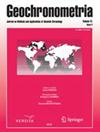钾长石的红外荧光(IR-RF):实验室间比较
IF 0.9
4区 地球科学
Q3 Earth and Planetary Sciences
引用次数: 3
摘要
摘要红外辐射荧光(IR-RF)是一种相对较新的沉积物剂量测年方法。这篇文章介绍了来自八个实验室的沉积长石的IR-RF测量的实验室间比较。对仪器背景、漂白、饱和和IR-RF信号的初始上升行为的可变性进行了比较。两个端元样本,一个是自然漂白的零剂量现代沙丘砂样本,一个是自然饱和的三叠纪砂岩样本(~250 Ma),用于实验室间的比较。本研究的主要发现是:(1)观测到的IR-RF信号在4000 Gy之后持续下降;(2)饱和样品的表观古剂量为1265±329 Gy;(3)在大多数情况下,现代模拟样品(自然漂白)的自然IR-RF信号高于使用太阳模拟器(SLS)的实验室诱导漂白6 h的信号。也就是说,实验室样品的漂白无法达到自然漂白的水平。详细讨论了调查结果,以及可能的解释。本文章由计算机程序翻译,如有差异,请以英文原文为准。
Infrared Radiofluorescence (IR-RF) of K-Feldspar: An Interlaboratory Comparison
Abstract Infrared Radiofluorescence (IR-RF) is a relatively new method for dosimetric dating of the depositional timing of sediments. This contribution presents an interlaboratory comparison of IR-RF measurements of sedimentary feldspar from eight laboratories. A comparison of the variability of instrumental background, bleaching, saturation, and initial rise behaviour of the IR-RF signal was carried out. Two endmember samples, a naturally bleached modern dune sand sample with a zero dose and a naturally saturated sample from a Triassic sandstone (~250 Ma), were used for this interlaboratory comparison. The major findings of this study are that (1) the observed IR-RF signal keeps decreasing beyond 4000 Gy, (2) the saturated sample gives an apparent palaeodose of 1265 ± 329 Gy and (3) in most cases, the natural IR-RF signal of the modern analogue sample (resulting from natural bleaching) is higher than the signal from laboratory-induced bleaching of 6 h, using a solar simulator (SLS). In other words, the laboratory sample bleaching was unable to achieve the level of natural bleaching. The results of the investigations are discussed in detail, along with possible explanations.
求助全文
通过发布文献求助,成功后即可免费获取论文全文。
去求助
来源期刊

Geochronometria
地学-地球科学综合
CiteScore
2.20
自引率
0.00%
发文量
1
审稿时长
>12 weeks
期刊介绍:
Geochronometria is aimed at integrating scientists developing different methods of absolute chronology and using them in different fields of earth and other natural sciences and archaeology. The methods in use are e.g. radiocarbon, stable isotopes, isotopes of natural decay series, optically stimulated luminescence, thermoluminescence, EPR/ESR, dendrochronology, varve chronology. The journal publishes papers that are devoted to developing the dating methods as well as studies concentrating on their applications in geology, palaeoclimatology, palaeobiology, palaeohydrology, geocgraphy and archaeology etc.
 求助内容:
求助内容: 应助结果提醒方式:
应助结果提醒方式:


